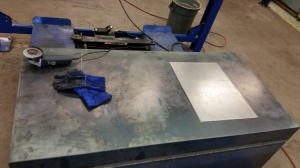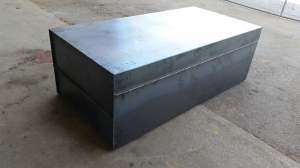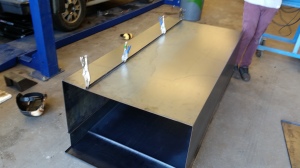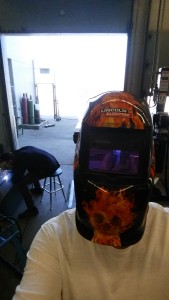Home » Search results for 'box'
Search Results for: box
I entered the VLF Radio Blocking Box: the results
I could still hear the Hum.
I entered the box at about 1:40 am last night and and soon as I lay down quietly inside it, the Hum was there, as loud as ever.
As a final step, I need to establish that the box does what it says it does (i.e. block essentially all VLF radio signals), and to have a physicist confirm my calculations regarding the radio skin depth of a 10 kHz radio wave for mild steel. If everything checks out, then this a serious piece of evidence against the VLF theory.
I’ll let you know if and when I’ll be shifting gears and moving on to the second hypothesis.
What I experienced going into the VLF-Blocking Box
Short answer: I’m not sure.
Last night I arrived home late after playing badminton and I was unable to sleep. I noticed that the bathroom fan wasn’t on, and I heard what seemed to be the Hum. So, after months of waiting, I put on some warm clothes, walked to where the Deming Box is located, and crawled into the box and pulled the hatch over the opening. Not that it matters at all from a scientific standpoint, but I didn’t experience any anticipation or excitement, no sense of culmination. It was simply time. My theory is that the world Hum is rooted – at least in part – in VLF radio frequencies (3 kHz – 30 kHz). The Deming Box is one piece of a classic blinded study design first envisioned by David Deming in his classic 2004 article, “The Hum – An Anomalous Sound Heard Around the World”. Full text access to this article can be unreliable, so if you find a copy of it, save it for your own personal use and reference. In that design, three identical-looking boxes are created. The first blocks VLF radio frequencies, the second box blocks to the best degree possible, all acoustic noise. The third box is a control and blocks neither. Hum hearer volunteers then enter the boxes randomly, and report their experiences. There are notable problems with the design, in particular the problem that it is impossible to not know that one has been placed inside an acoustic anechoic chamber. Blocking VLF radio frequencies is the easy part, which I think I’ve done. I used 18 gauge or thicker mild steel to create an enclosure that can block 10 radio skin depths for a 10 kHz wave. I’m waiting for a physicist to examine my physics work presented here.
And I’m not sure what happened when I went in the box. I brought a pair of ear protection muffs with me, in order to try to block outdoor ambient noise. But sitting on the ground beside the box, wearing the muffs, I couldn’t really pick out the Hum with any certainty. If the reader of this hears the world Hum, then I think you know exactly what I mean. That is, when the Hum is loud, there is no mistaking it. It behaves in a certain way. But when I took the ear muffs off, the overall sound seemed to increase. There is a ferry terminal not that far away, and ships also pass by on the ocean at night, so when the Hum is quiet, it starts being drowned out by the noise of daily life. I can’t be sure in this case.
I’ll move the box to a storage locker away from the city, which will block enough sound to let the Hum be heard late at night, and will add even more VLF radio blockage. Assuming my physics calculations are correct and that a I can get a good VLF meter inside the box to confirm, a negative result would cast doubt on the VLF theory. A positive result would be a big step forward.
I could be incorrect about the entire thing, but if so we move directly to the next most reasonable hypothesis.
More to come.
After months of delay, I finally entered the VLF Blocking (Deming) Box
I’ll provide a detailed report when I get back from work this evening.
Why Haven’t I gone into the Box Yet?
The Box is sitting in the woodshed, and a light coat of rust is creeping in a number of spots. All I have to do is crawl inside and see if it works. There is no risk, just a few minutes should tell the story.
But there’s a further issue. Readers will know that I talk very little about my own experience with, and suffering from, the Hum. I can add some more detail here. There was a period of perhaps one week, when living less than 10 km from the small town of Sechelt, BC, when I thought to myself: “Okay, this is really a nuisance now.” I used the ensuite bathroom fan to drown it out. But that’s as bad as it has ever been, which is nothing compared to the terrible torment of the people who write to me and the thousands of people who have entered their information into the database.
Rarely do I say much about my professional life, but I’ll mention that the World Hum Map and Database is one of several projects that I am juggling. A fews weeks ago I went up to Whistler, BC, to address the joint conference of the British Columbia Association of Mathematics Teachers and the Northwest Mathematics Conference Fall Conference. Quite seriously, in the hotel room the night before my talk, well after dinner in the lounge, I looked at the program and saw that I was incorrectly scheduled for a 90 minute session, rather than the 45 minute blocks that I always choose.
That was interesting.
I gave an evidence-based talk about raising mathematics classroom practices to the expert level, circa 1989 and, along the way, at least six people stood and walked out. Perhaps they didn’t like my off the cuff remarks about post-modernist discourse. Maybe it was my cynicism toward several of the more recent and embarrassing trends in education. Hard to say, but in any case, that speech actually marked the end of that part of my life. I’ve helped train every mathematics education graduate at UBC for the past 16 years. I’ve written the articles, spoke at the conferences, and on and on. I’ve made my point on the academic side of mathematics education.
Which brings me back to the Hum, because a big cognitive and temporal load is off my shoulders now, and I can get ready to finally get inside the Box and record the experience.
But there’s another possible issue: I haven’t heard the Hum in months. I’m hit by ambient sound 24/7, because as a matter of course, the bathroom fan runs all night long. When I can, I’ll find a quiet zone at night and listen. I pretty sure I’ll still hear it.
And I’ll let you know when I go in, and I’ll let you know what I hear.
But I will do it on my schedule. 🙂
Glen
Going into the Box
So, I guess it’s time to go in. I need to Shop-Vac the unit because it’s full of metal shards from the cutting. Also, I’ll need to put a ThermaRest on the bottom of the inside. A flashlight, an assistant, and a few minutes of quiet and I should know if I’ve blocked The Hum. If not, I’ll follow up with some outside and inside readings on the VLF spectrum. My portable VLF unit is not reliable, and I’m quickly searching out an affordable alternative. My only concern is that the Box is not yet on a trailer, and it is sitting in an garage on the Sunshine Coast of BC. Because of all the outdoor sounds that transmit through the side lattice of the garage, the ambient noise level may be too high the hear the Hum. So I’ll need to gather funds for a trailer, which can then be taken anywhere for testing.
But I work full time (more than full time actually), and I want to have a life, so I will do it soon.
Calling all Vancouver-area Hum Hearers: the VLF-Blocking Box is nearing completion
The VLF radio-blocking Deming Box is nearing completion – the final welds on the basic box should be finished within 48 hours. Then comes the tricky work: cutting a hole for the access hatch and welding it in. I’ll call in Jim Pike to do that work personally. The unit will be ready to go on the road within 20 days, funding for the trailer permitting.
Technical note: there also needs to be a proof of concept; that is, I need to demonstrate that the box actually does what it claims to do, which is blocking radio signals down to a frequency of 3 kHz, and preferably lower. I have the technology on hand to do that, but I’ll be checking with a few folks on the Yahoo VLF Forum regarding that before the experiment begins.
So during the summer, most likely mid-late July, I’ll be ready for the first volunteers to go into the box so that we can provide initial and informal results to the Hum world. If you live no further east than Hope, BC and no further north than Whistler, and you would be willing to participate, then please contact me. Alternatively, if you are travelling to the Vancouver area during that time period, that will work as well.
It’s finally time to fund the Deming Box Experiment (donation information below)
Readers will know that there is no advertising of any kind on this blog or on the World Hum Map website. I want to avoid the slightest hint of being beholden to, or unduly influenced by, anybody or any agency. But three years after I first read about Deming’s proposed experiment, I’ve made no solid progress on it. Numbers of people have come forward with great suggestions and offers of assistance, but these offers typically fizzle out and it’s been very difficult to take action because of time and money.
Recently, a commenter essentially wrote, “Enough with the talk. Get the Deming Box Experiment done.” And I think he was correct in his frustration.
This means I need help with financing the project.
Revenue Canada (the Canadian federal tax agency) has elaborate and intricate bureaucratic regulations for Not-for-Profit Organizations, and even though I may eventually need to, I’d rather not go down the road of lawyers, accountants, and so on. KickStarter has far too much overhead and they require finished “camera-ready” technical specifications. I think that PayPal, despite its limitations and fee gouging, presents the simplest method of generating the funds to get things done.
For transparency and for those who want to know exactly where the dimes and dollars go, every month I will post a screenshot of the PayPal account summary page.
Thank you.
Glen




